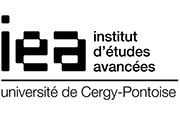-
Dr. Vincent Hakim
Laboratoire de Physique Statistique - ENS, Paris
Collective cell migration : an introduction from a physics viewpoint
-
Prof. Giambattista Giacomin
Université Paris Diderot, Paris
Dynamical models on random graphs and Fokker-Planck equations
We address the issue of the proximity of interacting diffusion models on large graphs with a uniform degree property and a corresponding mean field model, i.e. a model on the complete graph with a suitably renormalized interaction parameter. The purpose of this talk is twofold: (1) to explain that this proximity can be established in great generality on finite time horizon; (2) to remark that in reality this result is unsatisfactory when it comes to applying it to systems with N large but finite, notably the values of N can be reached in simulations or that correspond to the typical number of interacting units in a biological system.
`
-
Dr. Stefano Lepri
Istituto dei Sistemi Complessi - CNR - Sesto Fiorentino, Italy
Coupled-oscillators chains out of equilibrium
I will review some properties of models of one-dimensional
chains driven off equilibrium by temperature or force gradients.
In particular I will deal with two paradigmatic systems, the Hamiltonian XY model and the discrete nonlinear Schr"odinger equation.
S. Iubini, S. Lepri, R. Livi, A. Politi
Boundary-induced instabilities in coupled oscillators
arXiv:1401.2846 Phys. Rev. Lett. 112, 134101 (2014).
S. Iubini, S. Lepri, R. Livi, A. Politi
Coupled transport in rotor models
New J. Phys. 18(2016)083023.
-
Dr. Simona Olmi
INRIA Sophia Antipolis - MathNeuro Team
Controlling seizure propagation in large-scale brain networks
-
Prof. Dr. Markus Bär
Head of the Department of Mathematical Modeling and Data Analysis
Physikalisch-Technische Bundesanstalt, Berlin, Germany
Pattern Formation in Active Fluids
Active fluids contain a large number of active agents which consume energy in order to move or exert mechanical forces. Examples include intracellular flows driven by the activity of molecular motors in networks of biopolymers inside cells and bacterial swarms and suspensions of microswimmers. The talk surveys two representative examples for spatiotemporal self-organisation in active fluids: (i) mechano-chemical waves in small droplets (microplasmodia) of the slime mold Physarum polycephalum and (ii) the so called -mesoscale turbulence- in dense suspensions of swimming bacteria. We show that a variety of mechanochemical patterns inside the droplets can be reproduced in a model, that considers Physarum cells as an active poroelastic two-phase medium coupled to an intracellular calcium dynamics. The experimentally observed net motion of the droplets is obtained if one assumes a stick-slip motion of the droplets on the substrate. Mesoscale turbulence in bacterial suspensions is found to be caused by the interplay of active motion, local alignment of swimmers and long-range hydrodynamic interactions with the help of a continuum model derived from the dynamics of individual swimmers.
-
Prof. Hugues Chaté
CEA, Saclay - Member of the Steering committee, ISC-PIF, Paris
Lead Editor, Physical Review Letters
Chair Professor, Beijing Computational Science Research Center
Synchronization and transport in active matter
-
Dr. Bastien Fernandez
CNRS - Université Paris-Diderot, Paris
The mathematics of asymptotic stability in the Kuramoto model
The phenomenology of the Kuramoto model (continuum limit) strongly relies on the nonlinear stability of its stationary states. To understand and to rigorously assert stability in this infinite-dimensional setting have been long-standing challenges, and show similar features of the Landau damping in the Vlasov equation. In this talk, I will review results on stability conditions and asymptotic stability of various stationary states, that mathematically confirm the intuited phenomenology and its dependence on parameters.
-
Prof. Alessandro Torcini
Université de Cergy-Pontoise, Pontoise
Collective Irregular Oscillations in Balanced Neural Networks
We revisit the dynamics of a prototypical model of balanced activity in networks of spiking neutrons. A detailed investigation of the thermodynamic limit for fixed density of connections (massive coupling) shows that, when inhibition prevails, the asymptotic regime is not asynchronous but rather characterized by a self-sustained irregular, macroscopic (collective) dynamics. So long as the connectivity is massive, this regime is found in many different setups: leaky as well as quadratic integrate-and-fire neurons; large and small coupling strength; weak and strong external currents.
Ekkehard Ullner, Antonio Politi, Alessandro Torcini,
Ubiquity of collective irregular dynamics in balanced networks of spiking neurons
arXiv:1711.01096

Laboratoire de Physique Statistique - ENS, Paris
Collective cell migration : an introduction from a physics viewpoint
Université Paris Diderot, Paris
Dynamical models on random graphs and Fokker-Planck equations
We address the issue of the proximity of interacting diffusion models on large graphs with a uniform degree property and a corresponding mean field model, i.e. a model on the complete graph with a suitably renormalized interaction parameter. The purpose of this talk is twofold: (1) to explain that this proximity can be established in great generality on finite time horizon; (2) to remark that in reality this result is unsatisfactory when it comes to applying it to systems with N large but finite, notably the values of N can be reached in simulations or that correspond to the typical number of interacting units in a biological system. `
Istituto dei Sistemi Complessi - CNR - Sesto Fiorentino, Italy
Coupled-oscillators chains out of equilibrium
I will review some properties of models of one-dimensional chains driven off equilibrium by temperature or force gradients. In particular I will deal with two paradigmatic systems, the Hamiltonian XY model and the discrete nonlinear Schr"odinger equation.
S. Iubini, S. Lepri, R. Livi, A. Politi Boundary-induced instabilities in coupled oscillators arXiv:1401.2846 Phys. Rev. Lett. 112, 134101 (2014).
S. Iubini, S. Lepri, R. Livi, A. Politi Coupled transport in rotor models New J. Phys. 18(2016)083023.
INRIA Sophia Antipolis - MathNeuro Team
Controlling seizure propagation in large-scale brain networks
Head of the Department of Mathematical Modeling and Data Analysis
Physikalisch-Technische Bundesanstalt, Berlin, Germany
Pattern Formation in Active Fluids
Active fluids contain a large number of active agents which consume energy in order to move or exert mechanical forces. Examples include intracellular flows driven by the activity of molecular motors in networks of biopolymers inside cells and bacterial swarms and suspensions of microswimmers. The talk surveys two representative examples for spatiotemporal self-organisation in active fluids: (i) mechano-chemical waves in small droplets (microplasmodia) of the slime mold Physarum polycephalum and (ii) the so called -mesoscale turbulence- in dense suspensions of swimming bacteria. We show that a variety of mechanochemical patterns inside the droplets can be reproduced in a model, that considers Physarum cells as an active poroelastic two-phase medium coupled to an intracellular calcium dynamics. The experimentally observed net motion of the droplets is obtained if one assumes a stick-slip motion of the droplets on the substrate. Mesoscale turbulence in bacterial suspensions is found to be caused by the interplay of active motion, local alignment of swimmers and long-range hydrodynamic interactions with the help of a continuum model derived from the dynamics of individual swimmers.
CEA, Saclay - Member of the Steering committee, ISC-PIF, Paris
Lead Editor, Physical Review Letters
Chair Professor, Beijing Computational Science Research Center
Synchronization and transport in active matter
CNRS - Université Paris-Diderot, Paris
The mathematics of asymptotic stability in the Kuramoto model
The phenomenology of the Kuramoto model (continuum limit) strongly relies on the nonlinear stability of its stationary states. To understand and to rigorously assert stability in this infinite-dimensional setting have been long-standing challenges, and show similar features of the Landau damping in the Vlasov equation. In this talk, I will review results on stability conditions and asymptotic stability of various stationary states, that mathematically confirm the intuited phenomenology and its dependence on parameters.
Université de Cergy-Pontoise, Pontoise
Collective Irregular Oscillations in Balanced Neural Networks
We revisit the dynamics of a prototypical model of balanced activity in networks of spiking neutrons. A detailed investigation of the thermodynamic limit for fixed density of connections (massive coupling) shows that, when inhibition prevails, the asymptotic regime is not asynchronous but rather characterized by a self-sustained irregular, macroscopic (collective) dynamics. So long as the connectivity is massive, this regime is found in many different setups: leaky as well as quadratic integrate-and-fire neurons; large and small coupling strength; weak and strong external currents.
Ekkehard Ullner, Antonio Politi, Alessandro Torcini, Ubiquity of collective irregular dynamics in balanced networks of spiking neurons arXiv:1711.01096


